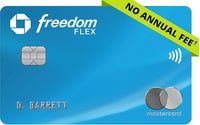Citi Double Cash Card vs. Chase Freedom Flex

Key takeaways
- Thanks to its generous cash back rates, the Chase Freedom Flex® can potentially earn you more than the Citi Double Cash® Card.
- Additionally, the Chase Freedom Flex offers the same welcome bonus as the Citi Double Cash offers — but with a much lower spending requirement.
- Still, rotating categories can be a chore to keep track of; if you prefer simplicity, the Citi Double Cash can be the better option.
The Citi Double Cash® Card and Chase Freedom Flex®* are both no-annual-fee rewards cards, but depending on what you value the most in your rewards card, their worth varies. For example, if you’re more interested in maximizing your rewards potential or earning a significant sign-up bonus, the Chase Freedom Flex is a good pick. If you’d rather swipe your card without having to keep track of rotating bonus categories, you’re probably better off with the Citi Double Cash.
Still, you’ll never know which option is best for you until you do your research. Luckily, we’ve done it for you. Below, we’ll see how the two cards stack up against each other.
Main details
| Citi Double Cash Card | Chase Freedom Flex | |
|---|---|---|
| Welcome bonus | Earn $200 cash back after you spend $1,500 on purchases in the first six months of account opening. | $200 cash bonus after spending $500 within the first three months |
| Rewards rate |
|
|
| Intro APR | 0% intro APR for 18 months on balance transfers (18.49% – 28.49% variable APR after) | 0% intro APR for 15 months on purchases and balance transfers (19.74% – 28.49% variable APR after) |
| Annual fee | $0 | $0 |
Citi Double Cash vs. Chase Freedom Flex highlights
As far as rewards go, the Chase Freedom Flex has the potential to earn you a lot more cash back. But if you’re planning a balance transfer, you might want to consider the Citi Double Cash instead. Here’s how the two cards compare in a variety of categories:

Chase Freedom Flex®

Chase Freedom Flex®
Which card earns the most?
While it’s clear that the Chase Freedom Flex and the Citi Double Cash can earn the same welcome bonus in the first year, let’s take a look at which card provides more value in the long run.
Citi Double Cash vs. Chase Freedom Flex spending example
Say you spend $15,900 per year on a credit card, $2,250 of which is spent at restaurants, $650 on travel and $150 at drugstores.
With the Chase Freedom Flex, you’ll earn $32.50 in cash back if you book that $650 in travel through the Chase Ultimate Rewards portal, $67.50 in cash back on the $2,250 spent at restaurants and $4.50 in cash back on $150 in drugstore purchases.
Then, say you max out the annual spending limit for the Chase Freedom Flex’s rotating bonus categories. The most you can earn from rotating categories each quarter is $75 — $300 per year — which would require spending $6,000 per year in these rotating bonus categories (which typically include categories like grocery stores, gas stations, select streaming services and select merchant purchases).
Lastly, you’ll also earn 1 percent cash back on the rest of your non-bonus-category spending ($6,850), earning $68.50 in cash back. In total, that means you’d get $473 in cash back per year.
As for the Citi Double Cash, $15,900 in annual spending would earn you $159 in cash back when you make a purchase and $159 after you pay off your purchases, which brings your total cash back to $318.
Overall, this spending example demonstrates how bonus categories can make a significant difference in your cash back earnings, even though it might take a bit more effort to stay on top of them.
Why should you get the Citi Double Cash?
The Citi Double Cash is the easier-to-use card of the two, since you won’t need to keep track of any bonus categories. Still, the card can be very rewarding if you use it on as many purchases as you can, and its rewards rate is highly competitive when it comes to flat-rate cash back credit cards.
“I use my Citi Double Cash for most of my online shopping, and I love it for its straightforward cash back rewards,” says Alice Lesperance, a credit cards editor at Bankrate. “Because it was one of the first rewards cards I got, I liked that it encouraged paying off purchases right away by offering 1 percent cash back (on top of the initial 1 percent offered when you make the purchase.) I also took advantage of the Double Cash’s 18-month 0 percent APR balance transfer offer, and the process was easy to navigate and helped me pay down some old credit card debt.”
Additional benefits
The Citi Double Cash has an intro APR offer on balance transfers. For that reason, we recommend this card if you’re looking for a balance transfer card that will still provide value once you’ve paid off your debt.
You’ll also enjoy benefits like Citi Entertainment, which provides access to VIP events like concerts, sporting events and more, along with $0 fraud liability and emergency card replacement.
Redemption options
You can redeem your cash back for statement credits, direct deposits, checks or Citi ThankYou points. Keep in mind that, even if you redeem your rewards for Citi ThankYou points, you won’t be able to transfer your rewards to hotel or airline partners.
Recommended credit score
The Citi Double Cash requires a good to excellent credit score, which is a FICO score of 670 to 850.
Why should you get the Chase Freedom Flex?
The Chase Freedom Flex provides many excellent opportunities to earn cash back at a higher rate. If you don’t mind keeping track of rotating bonus categories, activating categories each quarter and making sure to use the card for bonus category spending, the Chase Freedom Flex can be very rewarding.
“My Chase Freedom Flex is one of my favorite cards. I make sure to maximize every cent of available spending in rotating categories, particularly if the harder-to-use ones fit my needs,” says Ryan Flanigan, Bankrate credit cards writer. “In my opinion, it’s the strongest no-annual-fee card on the market by a significant margin.”
Additional benefits
If you’re planning a big purchase (or a big purchase and a balance transfer), the Chase Freedom Flex may be a better choice since it includes an intro APR offer on both purchases and balance transfers.
With the Chase Freedom Flex, you’ll enjoy purchase protection, zero liability protection, extended warranty protection, trip cancelation and interruption insurance, cellphone protection, an auto rental collision damage waiver, travel and emergency assistance services, fraud alerts and more.
Redemption options
This card offers more redemption options than the Citi Double Cash, as you can redeem your cash back for statement credits, direct deposits, travel and events booked through Chase Ultimate Rewards, shopping with PayPal and Amazon, gift cards and merchandise.
With this card, note that you’re technically earning Chase Ultimate Rewards points. If you have a premium Chase travel card like the Chase Sapphire Preferred® Card or Chase Sapphire Reserve®, you can transfer Chase Ultimate Rewards points to travel partners. This can help you to maximize rewards value even further, since travel rewards are some of the most valuable rewards in the credit card market.
Recommended credit score
Like the majority of top rewards credit cards, the Chase Freedom Flex requires a good to excellent credit score (at least 670) to qualify.
The bottom line
While the Citi Double Cash offers an exceptional rewards rate for a flat-rate cash back credit card, the Chase Freedom Flex offers more opportunities to earn rewards. Still, there are other factors to consider, such as whether you’re planning to carry or transfer a balance and how much effort you’re willing to put into your credit card rewards strategy.
*The information about the Chase Freedom Flex® has been collected independently by Bankrate.com. The card details have not been reviewed or approved by the card issuer.




